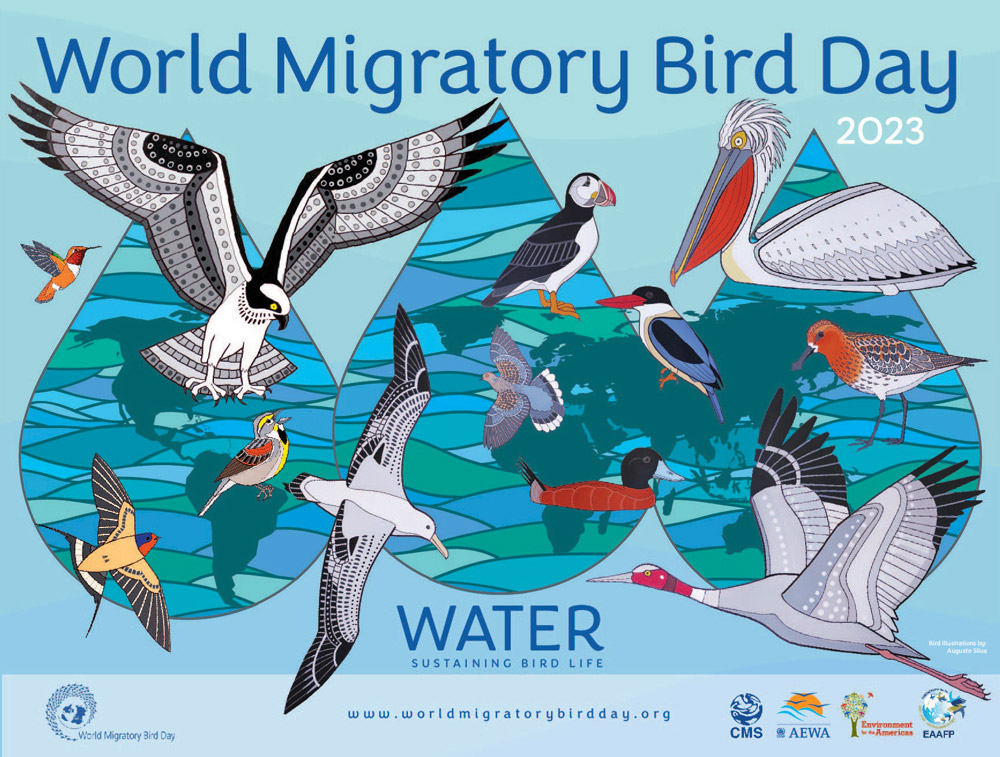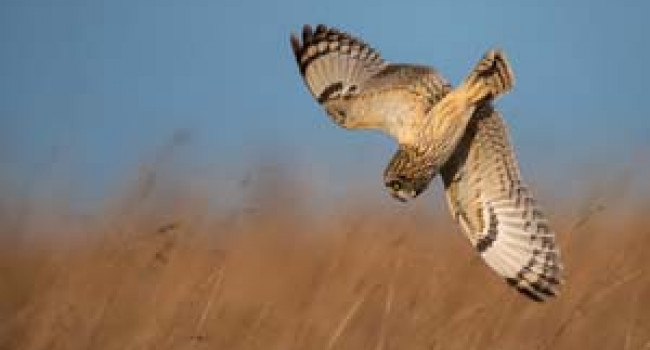
The astonishing migration of Scotland’s Arctic Skuas
On World Migratory Bird Day, BTO Senior Research Ecologist Nina O’Hanlon explores the fascinating findings of the Arctic Skua tracking project.
Nina is a Senior Research Ecologist and part of the Wetland and Marine Research Team, based within BTO Scotland. Her role involves reporting, analysis and fieldwork with a focus on marine birds.
Picture the scene: a flock of Kittiwakes, casually dip-feeding and floating around on a calm sea. Then, suddenly, havoc arises as a dark shape zips into view – an elegant but formidable seabird – an Arctic Skua.
There’s something exhilarating about the aerobatic display that ensues as the skua pursues its chosen victim, both birds twisting and turning high in the sky and back down to the sea, until finally, the Kittiwake regurgitates its last meal or the Arctic Skua gives up and finds a new and unsuspecting target.
Migratory pirates
Skuas are often called the pirates of the sea, a name which is well-deserved: powerful and agile, they chase and harass other seabirds, stealing much of their food instead of catching their own – a behaviour known as kleptoparasitism. In North America, Arctic Skuas are even called Parasitic Jaegers due to their habit of pursuing species such as auks, gulls and terns and forcing them to drop their food.
With the populations of many of our seabird species falling, it is not surprising that Arctic Skuas – which depend largely on these other birds for food – have also experienced severe declines. The UK breeding population, restricted to north and west Scotland, declined by 70% between 2000 and 2019! And these declines have not just occurred in Scotland. Arctic Skuas are also struggling in other parts of northern Europe including the Faeroes, Iceland and Norway.
The UK breeding population of Arctic Skuas has declined by 70% between 2000 and 2019, a trend that is reflected in other parts of northern Europe including the Faeroes, Iceland and Norway.
These declines are thought to be due to poor food availability during the breeding season, which has caused declines in the seabirds the skuas steal from and therefore reduced the food available for the skuas. A lack of food means the skuas can’t provide for their chicks, so fewer young birds survive to fledge each year. This is exacerbated in some colonies by predation of chicks by the larger Great Skua, which increases in years where this species’ alternative fish prey is limited. Low food supplies may also have implications for the health and survival rates of the adult birds themselves.
To fully understand what is causing Arctic Skua declines, and to identify effective conservation actions, we need to understand where the skuas are distributed during the winter months.
Arctic Skuas are long-distance migratory seabirds, and spend only around a third of the year at the breeding colony: after raising their young, they leave their northern colonies to spend their non-breeding season in warmer, more productive waters in the southern hemisphere. Therefore, to fully understand what is causing the large declines in Arctic Skuas, and to help identify effective conservation actions, we need to understand where the skuas are distributed during the rest of the year, during the northern hemisphere’s winter months.
Tracking revelations
Recent advances in technology have allowed scientists to develop tiny tracking devices which are light enough to attach to birds, and enable us to follow their movements for potentially thousands of miles.
At BTO, we wanted to shed light on the migration routes and wintering areas of the Arctic Skuas breeding in Scotland. To do this, we decided to attach geolocators to adult Arctic Skuas breeding on Fair Isle, Shetland, and Rousay, Orkney, in 2017 and 2018.
These small tracking devices weigh less than 1 g and are attached to a plastic colour ring, which is engraved with a unique code and placed on each bird’s right leg. Each bird is identifiable by the code on its ring – for example, AAA, AAH, AAJ and so on.
Each skua’s movements are saved to the geolocators themselves, so we needed to recapture the skuas to remove the tracking devices and download the all-important data.
Each skua’s movements are saved to the geolocators themselves, which means that we needed to recapture the skuas to remove the tracking devices and download the all-important data. Thanks to a lot of dedicated effort in subsequent years, six devices were retrieved from Fair Isle and four from Rousay.
So where did the Scottish Arctic Skuas go?
During our autumn, most individuals from both the Fair Isle and Rousay colonies migrated south after the breeding season, moving through the North Sea and the English Channel then along the Iberian Peninsula and off West Africa. However, in both years it was tracked, skua AAU from Rousay headed west instead, then migrated southwards over the Atlantic before heading south-east to the coast of Portugal.
Amazingly, given the relatively small number of birds that we tracked, we saw that skuas from the same colony wintered across the whole range of the Atlantic Ocean. AAU and two other birds from Fair Isle wintered around the Canary Current off West Africa, whilst the remaining individuals continued south and then either headed west to winter around the Patagonian Shelf, or east to the Benguela Current – covering distances over 10,000 km! Although existing ringing data has suggested that Arctic Skuas breeding in Scotland winter off West and southern Africa, our tracking study was the first time they have been shown to winter off South America.
Existing ringing data has suggested that Arctic Skuas breeding in Scotland winter off West and southern Africa, but our tracking study was the first time they have been shown to winter off South America.
In spring, individuals that wintered around the Patagonian Shelf and Benguela Current returned north, mainly via West Africa. However, unlike in autumn, all individuals, including those wintering in the Canary Current, headed into the mid-Atlantic before returning to Scotland. This revealed that the mid-Atlantic is an important staging area (like a favourite motorway service station) for Arctic Skuas during their northbound migration, where they feed up to get in good body condition before the breeding season. This mid-Atlantic area is a region of high marine productivity, and therefore high food availability. Part of the region was recently designated as a Marine Protected Area due to its importance for numerous seabird species including Kittiwakes, Arctic Terns and Puffins.
Our study revealed that the mid-Atlantic Ocean is an important staging area for Arctic Skuas, where they feed up to get in good body condition before the breeding season.
The wider picture
Whilst we were tracking Arctic Skuas in Scotland, researchers in the Faeroes, Norway and Svalbard were doing the same. A total of 129 Arctic Skuas have been tracked across these four populations since 2009, with many individuals, including four from Scotland, being tracked for multiple years. In nearly every case, skuas with multiple years of data wintered in the same areas and followed similar migratory routes each year.
As we saw in Scotland, skuas from the same breeding population migrated to different wintering areas across the entire Atlantic Ocean. Most individuals from these more northerly populations spent time in the mid-Atlantic Ocean to feed up during both autumn and spring migrations, further highlighting how important this area is for migrating Arctic Skuas.
By tracking Arctic Skuas from multiple populations, we can also explore whether differences and similarities in migratory routes, staging areas and wintering areas are reflected in differences in population trends. For example, Arctic Skuas are declining in Svalbard to a lesser extent than they are in Scotland, the Faeroes and Norway. Most skuas from Svalbard didn’t winter as far south as those from the other populations, and they tended to stage further west in the mid-North Atlantic during migration. This could indicate that the Svalbard skuas are finding more food or are encountering fewer threats in these areas, compared to the staging areas used by the other populations.
The impact of our research
Now we have a better understanding of where Arctic Skuas are distributed outside the breeding season, we can start to explore which threats they might encounter during migration and in what we refer to as their wintering areas (although, of course, it is summer in the southern hemisphere when the skuas are there).
For example, individuals migrating south through the North Sea, including those from Scotland, might be vulnerable to increased collision risk with offshore wind farms.
By tracking Arctic Skuas from multiple populations, we can start to explore whether differences and similarities in migratory routes, staging areas and wintering areas are reflected in differences in population trends.
Knowledge of the birds’ non-breeding locations will also help us identify the most effective conservation actions for these birds. Although a large area of the mid-Atlantic has already been designated as a Marine Protected Area, the tracking data highlight an area off West Africa that is also important for staging and wintering Arctic Skuas. If this was also designated as a Marine Protected Area it would benefit a wide range of seabirds, not just the skuas – as it is not just Arctic Skuas that are in decline. Many long-distance migrant seabirds are declining globally, and their conservation is a challenge: they depend on productive marine conditions over large ocean regions, and are likely to encounter a range of threats along their extensive migratory routes.
International collaborations, a key focus of World Migratory Bird Day, are therefore essential to conserve migrant seabirds such as Arctic Skuas, and allow us to continue to enjoy them, whether at their breeding colonies or passing by on an autumn seawatch.
Special thanks to the amazing BTO fieldwork team of Sarah Harris and John Calladine, the fantastic Helen and David Aiton on Rousay, and everyone who helped with fieldwork as well as all landowners, including Fair Isle Bird Observatory and NatureScot who provided in-the-field-support in Scotland. Thanks also to the rest of the BTO project team – Chris Thaxter, Greg Conway, Dawn Balmer and Liz Humphreys – and to Rob van Bemmelen and Katherine Snell.
Since the Arctic Skua research programme was established in 2017, BTO donors have donated more than £225,000 to fund the work. We are enormously grateful for this very generous support from a small number of committed individuals. The research could not have been delivered without this funding.
World Migratory Bird Day 2023
This blog post was created to celebrate World Migratory Bird Day (WMBD) 2023, a global event which increases the level of awareness about the threats that migratory birds are facing.
The theme of WMBD 2023 is Water, which highlights the importance of this resource for migrating birds – including for species like the Arctic Skua, which spends most of its life at sea and migrates thousands of kilometres over the ocean and across both hemispheres every year.
BTO’s Arctic Skua tracking project aims to understand where these birds spend their time when they’re not at their breeding colonies, so we can better inform global efforts to protect this species.
- Tracking Rousay’s Arctic Skuas was made possible by the dedication and skill of the fieldworkers behind the project. Read more in our other blog for WMBD 2023, written by skua experts Helen and David Aiton.
Volunteer for the Seabird Monitoring Programme
Alongside our tracking projects, we carry out long-term population monitoring of the internationally important breeding seabird colonies in the UK. Together, data from these projects help us understand their declines and drive positive change.
If you would like to help us monitor seabirds like the Arctic Skua, visit the Seabird Monitoring Programme pages to look for vacant survey sites near you.
Look for survey sites


















Share this page